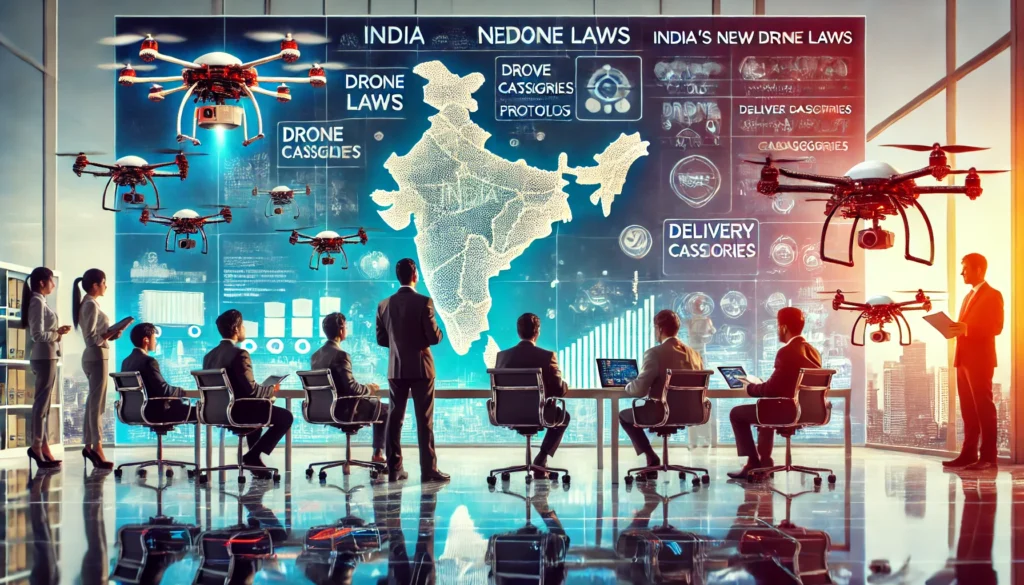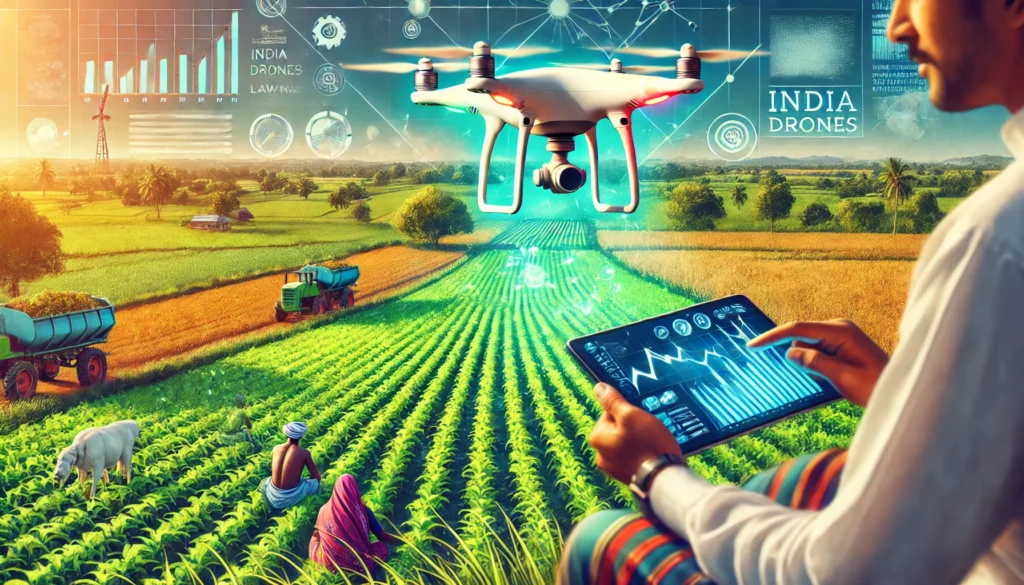The drone industry in India is witnessing rapid growth, with drones becoming indispensable for various sectors like agriculture, real estate, logistics, and surveillance. To regulate and support this booming industry, the Government of India introduced new drone laws in August 2021 under the Drone Rules, 2021. These rules are aimed at streamlining drone usage while ensuring safety, transparency, and accountability. This blog explores the impact of these new laws on commercial use and what businesses need to know.

1. Ease of Registration and Licensing
Under the new Drone Rules, the government has simplified the registration and licensing process. The earlier complex system of multiple approvals has been replaced by a single digital platform, called the Digital Sky platform. Businesses can now register their drones and apply for permissions through an easy-to-navigate online system. This simplification has made it easier for businesses to deploy drones for commercial purposes without facing bureaucratic hurdles.
2. Classification of Drones
The government has classified drones into five categories based on their weight:
- Nano (up to 250 grams)
- Micro (250 grams to 2 kg)
- Small (2 kg to 25 kg)
- Medium (25 kg to 150 kg)
- Large (more than 150 kg)
Different categories have different levels of regulatory requirements. For instance, nano drones used for non-commercial purposes are exempt from many approvals, while medium and large drones require stricter compliance measures. Businesses need to choose the appropriate drone category based on their operational requirements to avoid legal complications.
3. No Permission, No Takeoff (NPNT)
A significant regulation in the new drone laws is the NPNT protocol. This means that drones must have software that requires permission from the Digital Sky platform before taking off. This ensures that unauthorized drones do not take flight, improving overall airspace safety. Commercial drone operators must ensure their drones comply with NPNT to avoid penalties and operational disruptions.
4. Relaxation in Coverage
The new rules allow drones to be flown up to a height of 120 meters and permit operations even in restricted airspace with the appropriate permissions. This flexibility is crucial for businesses that need to cover large areas, such as in agriculture, mining, or surveillance.
5. Opportunities for Startups
India’s new drone laws offer immense opportunities for startups. The government has removed several barriers to entry, including the elimination of many licenses and approvals. This has encouraged new companies to enter the drone market, offering services like aerial photography, mapping, logistics, and surveying.
6. Insurance and Liabilities
While the rules don’t make insurance mandatory, businesses are encouraged to get liability insurance to cover potential accidents or damages. It’s crucial for companies using drones commercially to protect themselves from unforeseen circumstances.
7. Future of Drones in India
The new laws are expected to boost the use of drones across industries, especially in sectors like agriculture, healthcare, logistics, and defense. As drone technology evolves, businesses that adapt to these regulatory frameworks can expect to benefit from increased operational efficiency and reduced costs.
Conclusion
India’s new drone laws offer a balanced approach to promoting innovation while ensuring safety and accountability. Businesses looking to harness drone technology need to stay updated on these regulations, ensure compliance, and take advantage of the opportunities these laws present. With the right strategy, drones can significantly enhance productivity and operational capacity across industries.
भारत के नए ड्रोन कानूनों का वाणिज्यिक उपयोग पर प्रभाव: व्यवसायों को क्या जानना चाहिए
भारत में ड्रोन उद्योग तेजी से बढ़ रहा है, और कृषि, रियल एस्टेट, लॉजिस्टिक्स, और निगरानी जैसे क्षेत्रों में ड्रोन का उपयोग अनिवार्य होता जा रहा है। इस बढ़ते उद्योग को विनियमित करने और समर्थन देने के लिए, भारत सरकार ने अगस्त 2021 में ड्रोन नियम, 2021 के तहत नए ड्रोन कानूनों की घोषणा की। इन नियमों का उद्देश्य ड्रोन उपयोग को सुव्यवस्थित करना है जबकि सुरक्षा, पारदर्शिता, और उत्तरदायित्व सुनिश्चित करना है। यह ब्लॉग इन नए कानूनों का वाणिज्यिक उपयोग पर प्रभाव और व्यवसायों के लिए महत्वपूर्ण जानकारियों पर केंद्रित है।

1. पंजीकरण और लाइसेंसिंग में आसानी
नए ड्रोन नियमों के तहत, सरकार ने पंजीकरण और लाइसेंसिंग प्रक्रिया को सरल बना दिया है। पहले की जटिल प्रणाली को एकल डिजिटल प्लेटफ़ॉर्म, जिसे डिजिटल स्काई प्लेटफ़ॉर्म कहा जाता है, के माध्यम से प्रबंधित किया गया है। व्यवसाय अब आसानी से अपने ड्रोन का पंजीकरण कर सकते हैं और अनुमतियों के लिए ऑनलाइन आवेदन कर सकते हैं। इस सादगी ने वाणिज्यिक उद्देश्यों के लिए ड्रोन का उपयोग करने वाले व्यवसायों के लिए नौकरशाही अड़चनों को कम कर दिया है।
2. ड्रोन का वर्गीकरण
सरकार ने ड्रोन को उनके वजन के आधार पर पांच श्रेणियों में विभाजित किया है:
- नैनो (250 ग्राम तक)
- माइक्रो (250 ग्राम से 2 किलोग्राम तक)
- स्मॉल (2 किलोग्राम से 25 किलोग्राम तक)
- मीडियम (25 किलोग्राम से 150 किलोग्राम तक)
- लार्ज (150 किलोग्राम से अधिक)
विभिन्न श्रेणियों के लिए विभिन्न स्तरों के नियम होते हैं। उदाहरण के लिए, गैर-वाणिज्यिक उद्देश्यों के लिए नैनो ड्रोन को कई अनुमतियों से छूट दी गई है, जबकि मीडियम और लार्ज ड्रोन के लिए कड़े अनुपालन उपाय होते हैं। व्यवसायों को अपने परिचालन आवश्यकताओं के आधार पर उपयुक्त ड्रोन श्रेणी का चयन करना चाहिए ताकि कानूनी जटिलताओं से बचा जा सके।
3. नो परमिशन, नो टेकऑफ (NPNT)
नए ड्रोन कानूनों में एक महत्वपूर्ण प्रोटोकॉल NPNT है। इसका अर्थ है कि ड्रोन को उड़ान भरने से पहले डिजिटल स्काई प्लेटफ़ॉर्म से अनुमति लेनी होगी। यह सुनिश्चित करता है कि अनधिकृत ड्रोन उड़ान न भरें, जिससे वायुक्षेत्र की सुरक्षा बढ़ेगी। वाणिज्यिक ड्रोन संचालकों को यह सुनिश्चित करना चाहिए कि उनके ड्रोन NPNT का अनुपालन करते हों।
4. कवरेज में छूट
नए नियम ड्रोन को 120 मीटर की ऊँचाई तक उड़ान भरने की अनुमति देते हैं और उचित अनुमति के साथ प्रतिबंधित हवाई क्षेत्र में भी संचालन की अनुमति देते हैं। यह उन व्यवसायों के लिए महत्वपूर्ण है जिन्हें बड़े क्षेत्रों को कवर करने की आवश्यकता होती है।
5. स्टार्टअप्स के लिए अवसर
भारत के नए ड्रोन कानून स्टार्टअप्स के लिए असीमित अवसर प्रदान करते हैं। सरकार ने कई लाइसेंस और अनुमतियों को हटाकर उद्योग में प्रवेश की बाधाओं को कम कर दिया है। यह नए व्यवसायों के लिए ड्रोन सेवाओं को शुरू करने के अवसर प्रदान करता है।
6. बीमा और उत्तरदायित्व
यद्यपि बीमा अनिवार्य नहीं है, व्यवसायों को दुर्घटनाओं या नुकसान को कवर करने के लिए बीमा कराने की सलाह दी जाती है। यह व्यवसायों को अप्रत्याशित परिस्थितियों से बचाने के लिए महत्वपूर्ण है।
निष्कर्ष
भारत के नए ड्रोन कानून नवाचार को बढ़ावा देने के साथ-साथ सुरक्षा और उत्तरदायित्व सुनिश्चित करते हैं। व्यवसायों को इन नियमों के साथ अपडेट रहना चाहिए और अनुपालन करना चाहिए ताकि वे अपने संचालन को अधिक कुशल बना सकें। ड्रोन तकनीक के सही उपयोग से व्यवसायों को उत्पादकता और संचालन क्षमता में वृद्धि हो सकती है।
Follow my website for more interesting and insightful blogs!
